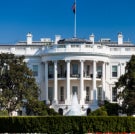Historical comparisons between the mass protests of 1968 and today’s student demonstrations in solidarity with Gaza are both imperfect and hard to avoid.
Just ten days ago Columbia University students pitched the first tent on the campus lawns, and already the protests have galvanised a generation of college students much in the same way the Vietnam War did 56 years ago.
It is not just the scale of the protests that have drawn comparisons, but the tactics. That is no accident: The protesters say they studied that generation-defining movement, methodically, before launching their own.
“We were only able to do this because the student organisers went into the archives of ‘68 and learned from what the older generation wrote about their experiences. A lot of organisers spent time and looked at how they did everything,” Majd, a Columbia undergrad who asked for their full name not to be published, told The Independent at the protest camp on Friday.
“We completely built this on their legacy,” Majd added.
While planning for their encampment, the Columbia protest organisers learned about how the ‘68 protesters dealt with security and how they navigated communications. They invited several participants of the historic protests to visit the encampment and speak.
“Even the idea of a solidarity camp at Columbia was based on the 1968 anti-Vietnam war protests,” said Ava Lyon-Sereno, a fellow Columbia student and protester. “It really feels like we’re continuing a tradition.”
Even before the sit-ins, student protests over the war in Gaza have been common across college campuses since the war broke out in October, following a surprise Hamas attack that killed 1,200 in Israel. The resulting conflict has killed over 34,000 Palestinians, most of them women and children, and aid blockages have resulted in famine conditions in northern Gaza, creating a humanitarian disaster. Hundreds of schools, and all of Gaza’s 12 universities, have been damaged or destroyed since the Israeli attacks began.
The Columbia protesters of today seem tame compared to their historical forebears. During the Vietnam War protests, a dean was briefly taken hostage and five buildings were seized. Then, as today, Columbia’s president called in police to break up the protests. Around 1,000 officers flooded onto campus, some on horseback, and made 700 arrests.
Times have changed, however. The students of Columbia today are hyper-focused and strategic — their primary aim is to convince the university to cut ties with Israeli academic institutions and divest from Israel-linked companies. Organisers hosted de-escalation training and media training for the protesters — the encampment even has a designated “nut zone” to protect students with nut allergies.
Students in the 1960s were horrified by the filtered and selective images of Vietnam that appeared on their television screens, while Gen Z now wakes up every morning to videos of death inches from their faces. If Vietnam was America’s first television war, Gaza may be the first time many young Americans have so intensely watched a live-streamed war.
Changes in technology have made the protesters’ mission even harder, too.
“It’s a whole new terrain now,” said Aidan Pari, a Columbia student and protester. “We have digital security that we need to look at — people trying to take pictures of people’s faces and dox them online. We have face detection software in the cameras at Columbia and the next morning you wake up and you’re suspended.”
“But we can use what they did in ‘68 as building blocks,” Pari said.
When Columbia’s administration ordered police to break up the budding protest camp, leading to the arrests of more than 100 students, it had the opposite of the intended effect. Gaza solidarity protests have spread like wildfire to dozens of campuses across the country — from coast to coast, at Yale, NYU, Ohio State University, Stanford University, Emory University, and Berkeley — in the past week, leading to a violent crackdown by police and the arrest of hundreds of students. They have even spread beyond borders to Paris, Sydney and Cairo.
A hot summer of protest now looms, and the stage is set for a showdown at the Democratic National Convention in Chicago, as it was in 1968.
“We’ll be marching with or without permits. This D.N.C. is the most important one since 1968, also in Chicago, when Vietnam War protesters and the Black liberation movement organized mass demonstrations that were violently repressed” Hatem Abudayyeh, national chair of the US Palestinian Community Network recently toldThe Chicago Tribune.
In ‘68, too, protests spread across the world — most consequently in Paris, where student protesters linked up with millions of striking workers and threatened to overthrow the government.
The students in Columbia have no such ambition, but this is an election year, and young voters are a crucial part of the coalition President Joe Biden needs to win in November.
Majd, the Columbia student, thinks the chances for Biden to win young voters back are slim.
“We’re in such a difficult situation because you have a genocidal enabler and you have Trump, which we don’t need to even get into how bad that is going to be,” they said.
“I feel like this generation — at least people in this camp — understand that we deserve an option that is neither of them.”



